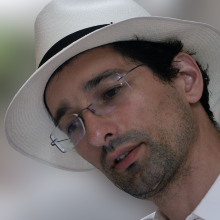It is our pleasure to welcome the 2022 Argyris Visiting Professor Gábor Csányi in Stuttgart where he will stay until 2 March 2023. Prof. Csányi very early recognised the power of machine learning for developing quasi-classical potentials to describe the structure and dynamics of solids and fluids.
While in Stuttgart, he will collaborate with the with the Holm and Kaestner group on applying and developing machine learning techniques to derive force fields (interatomic potentials) for materials from ab initio electronic structure data, i.e. https://www.nature.com/articles/s41524-020-00367-7.
Anyone interested to talk to him should contact me (holm@icp.uni-stuttgart.de) or Gabor directly. He already gave two talks and will give another one for those interesed in ML.
Th, Feb 23. III.
Atomic Cluster Expansion (ACE) and message-passing neural networks including Multi-ACE (MACE).
Content: Body ordering, linear models, nonlinear models, extrapolation
Time: 10:00
Location: ICP Seminar room, Allmandring 3
Prof Gábor Csányi has been nominated by Christian Holm, for the Argyris Visiting Professorship. His major research interests involve:
- materials modelling,
- electronic structure calculations,
- the calculation of potential energy surfaces with subsequent applications in molecular dynamics simulations,
- and - quite in general - various aspects of multiscale modelling and Quantum Mechanics / Molecular Mechanics methods.
His publication “Gaussian Approximation Potentials: The Accuracy of Quantum Mechanics, without the Electrons” with A.P. Bartok et al., appearing in 2010 in Phys. Rev. Lett., has made an enormous impact as evidenced by currently more than 1700 citations. His program suites GAP and SOAP have been the basis for many machine-learning-based potential developments from DFT calculations. The suites are publicly available on github and are used worldwide. Prof Csányi is author of more than 180 publications with an H-index beyond 50 – both together a substantial indicator for effective and productive scientific work – and remarkable in quality and impact.


